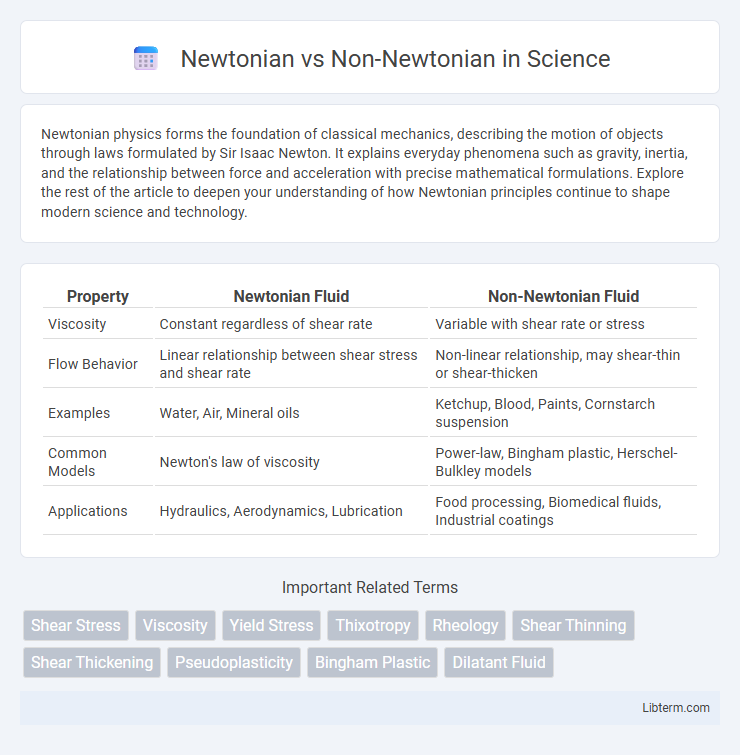Newtonian physics forms the foundation of classical mechanics, describing the motion of objects through laws formulated by Sir Isaac Newton. It explains everyday phenomena such as gravity, inertia, and the relationship between force and acceleration with precise mathematical formulations. Explore the rest of the article to deepen your understanding of how Newtonian principles continue to shape modern science and technology.
Table of Comparison
| Property | Newtonian Fluid | Non-Newtonian Fluid |
|---|---|---|
| Viscosity | Constant regardless of shear rate | Variable with shear rate or stress |
| Flow Behavior | Linear relationship between shear stress and shear rate | Non-linear relationship, may shear-thin or shear-thicken |
| Examples | Water, Air, Mineral oils | Ketchup, Blood, Paints, Cornstarch suspension |
| Common Models | Newton's law of viscosity | Power-law, Bingham plastic, Herschel-Bulkley models |
| Applications | Hydraulics, Aerodynamics, Lubrication | Food processing, Biomedical fluids, Industrial coatings |
Introduction to Fluid Mechanics
Newtonian fluids have a constant viscosity and their shear stress is directly proportional to the shear rate, following Newton's law of viscosity, which makes them predictable in fluid mechanics. Non-Newtonian fluids exhibit a variable viscosity that changes with shear rate or time, including types such as shear-thinning, shear-thickening, and viscoelastic fluids. Understanding the fundamental differences between Newtonian and Non-Newtonian fluids is crucial for accurately modeling flow behavior and designing systems in fluid mechanics applications.
Defining Newtonian Fluids
Newtonian fluids maintain a constant viscosity regardless of the applied shear rate, meaning their flow behavior is linearly proportional to the stress applied. Common examples include water, air, and most simple liquids, characterized by a steady relationship between shear stress and shear rate. This contrasts sharply with non-Newtonian fluids, which exhibit variable viscosity dependent on factors like shear rate or time.
Understanding Non-Newtonian Fluids
Non-Newtonian fluids exhibit variable viscosity that changes under stress or strain rate, unlike Newtonian fluids which maintain a constant viscosity regardless of applied force. Common examples of Non-Newtonian fluids include ketchup, oobleck, and blood, where their flow behavior cannot be described by a single viscosity value. Understanding these fluids involves studying their shear-thinning, shear-thickening, thixotropic, and rheopectic properties to predict their response in industrial and natural processes.
Key Differences: Newtonian vs Non-Newtonian
Newtonian fluids maintain a constant viscosity regardless of the applied shear rate, exemplified by water and air, which flow predictably under varying conditions. Non-Newtonian fluids, such as ketchup and cornstarch solutions, exhibit variable viscosity that changes with shear rate or stress, displaying behaviors like shear thinning or shear thickening. The fundamental difference lies in how these fluids respond to applied force: Newtonian fluids follow a linear relationship between shear stress and shear rate, whereas Non-Newtonian fluids demonstrate nonlinear or time-dependent responses.
Viscosity and Shear Stress Explained
Newtonian fluids maintain a constant viscosity regardless of the applied shear stress, meaning their flow behavior remains uniform under varying stress conditions. Non-Newtonian fluids exhibit variable viscosity that changes with the magnitude or duration of shear stress, resulting in behaviors such as shear thinning, shear thickening, or time-dependent viscosity. The relationship between shear stress and shear rate in Newtonian fluids is linear, while in Non-Newtonian fluids it can be nonlinear, reflecting complex internal structures and interactions.
Real-World Examples of Newtonian Fluids
Water, air, and most common oils are classic Newtonian fluids, exhibiting a constant viscosity regardless of the applied shear rate. These fluids flow predictably under stress, making them ideal for engineering applications such as hydraulic systems, lubrication, and aerodynamic testing. The steady behavior of Newtonian fluids contrasts sharply with non-Newtonian fluids like ketchup or blood, whose viscosity changes under varying force.
Diverse Types of Non-Newtonian Fluids
Non-Newtonian fluids exhibit varied flow behaviors that differ from the constant viscosity of Newtonian fluids like water. Diverse types of Non-Newtonian fluids include shear-thinning fluids such as ketchup, which become less viscous under stress, and shear-thickening fluids like cornstarch suspensions that harden when shaken or impacted. Other examples include thixotropic fluids, which decrease in viscosity over time under constant shear, and rheopectic fluids, which increase in viscosity under prolonged shear stress.
Applications in Industry and Technology
Newtonian fluids, such as water and air, exhibit constant viscosity regardless of shear rate, making them ideal for applications like hydraulic systems, lubrication, and fluid transport in pipelines. Non-Newtonian fluids, including polymers, paints, and drilling muds, demonstrate variable viscosity under stress, which is exploited in industries like food processing, pharmaceuticals, and cosmetics for controlled flow and texture. Understanding the rheological behavior of both fluid types enhances efficiency in manufacturing processes, quality control, and innovative material design.
Experimental Methods for Identifying Fluid Types
Experimental methods for identifying Newtonian versus non-Newtonian fluids primarily involve rheological testing using viscometers and rheometers that measure viscosity under varying shear rates. Newtonian fluids exhibit constant viscosity regardless of shear rate, while non-Newtonian fluids show viscosity changes reflecting shear-thinning, shear-thickening, or viscoplastic behavior. Techniques such as rotational viscometry, capillary flow, and oscillatory shear tests provide quantitative data to distinguish fluid types by analyzing shear stress versus shear rate relationships.
Future Trends in Fluid Dynamics Research
Future trends in fluid dynamics research emphasize the development of advanced models capturing complex behaviors of Non-Newtonian fluids, particularly in biomedical and industrial applications. Innovations in computational fluid dynamics (CFD) leverage machine learning to simulate Newtonian and Non-Newtonian fluid flow with enhanced precision and reduced computational cost. Emerging materials with tunable viscosity properties drive exploration into hybrid fluids that challenge traditional Newtonian assumptions, expanding practical uses in soft robotics and microfluidics.
Newtonian Infographic

 libterm.com
libterm.com